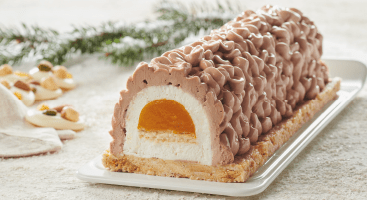Story and Tradition of Yule Log Cake

Do we actually know why we serve log-shaped cakes for Christmas?
Offering more than just a pretty face, this tasty “bûche de Noël” (as they say in French) known to most as a yule log, this cake is a tradition in France. The history of this tradition dates back to pagan rituals.
Years ago in the middle ages during the extreme cold and winter periods families would burn logs of wood for warmth, particularly a single log of wood awaiting the better, warmer weather.
Some at the time believed a log that burned out in less than three days was a bad omen.
Overtime heating devices were updated and modernized and the need for burning wood became less and less necessary. However, as "the log" was already engrained in the culture, the log traded its place in the fireplace for a more delicate and decorative place, and the symbolic meaning was maintained.
The log was a sign of blessing to protect the house, and the family living inside of it, the logs were burned for the occasion of Christmas Eve. The log had to be big enough to burn all night long.
Different types of woods had different meanings behind them:
- Wood from a fruit tree were a symbol of abundance,
- Robust tree such as oak or beech would have good sparks: the higher the sparks were, the better the upcoming year will be.
The tradition of lighting of the log, is usually placed on a bed of moss, blessed with sprinkles of oil, cooked wine, saltwater, honey, olive oil, the offering was then made by the oldest and the youngest member of the family, symbolizing the transmission.
Evolution of the edible log version
Lifestyle have evolved over time and huge, busy cities appeared, fireplaces became smaller and smaller and then non existent, replaced with heaters and stoves.
Logs were then placed in the middle of tables instead of fireplaces. Seen now as a dinner table center-piece. Extravagant logs were hollowed out and decorated with fruits, chocolate and gingerbread.
The fancier versions even mimic the shape of a wooden log, with decorations imitating bark.
Who invented the first yule log cake?
There are many stories that make the rounds but according to a article from My Persian Kitchen the inventor of the Yule log could be:
- The Parisian pastry chef Antoine Charadot from rue de Buci in Paris. In 1879 - created a rolled sponge cake filled with buttercream.
- A pastry apprentice working at Paris city hall in 1834.
- Another pastry chef from Lyon in the 1860s.
- Or the personal pastry chef of Prince Charles III of Monaco, Pierre Lacam. He was a famous pastry chef of the “Belle Epoque”, in 1898 / 1899. In his book “Mémorial historique et géographique de la pâtisserie” published in 1863 he writes about yule log but as he shares recipes from others and he spent only two years working for the Prince of Monaco, we cannot be sure yule log was his creation.
Valrhona has created a few of their own versions of the Yule log
Since the start of the Yule log recipes, Christmas yule logs were generally made using swiss roll cake and buttercream, usually pre-decorations with festive décor, with a general flavor of Vanilla and/or chocolate.
And that Ladies and Gentlemen is the story behind the Yule log.
 Microsoft Edge
Microsoft Edge
 Google Chrome
Google Chrome
 Mozilla Firefox
Mozilla Firefox
 Opéra
Opéra


